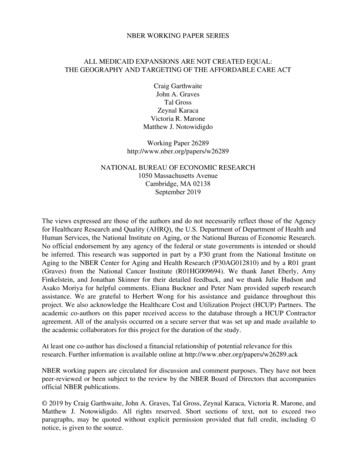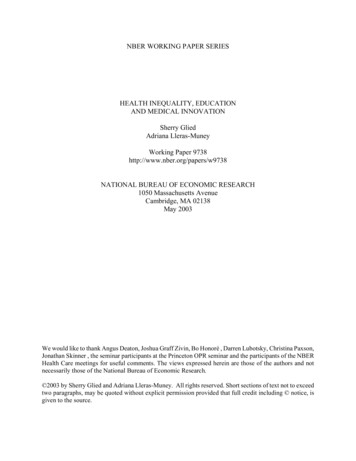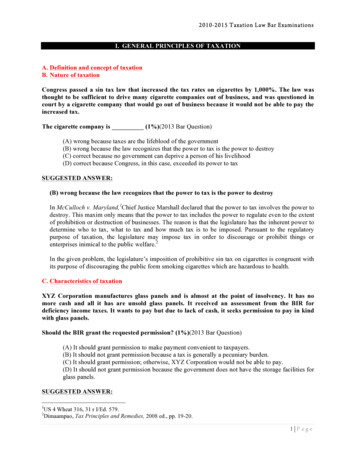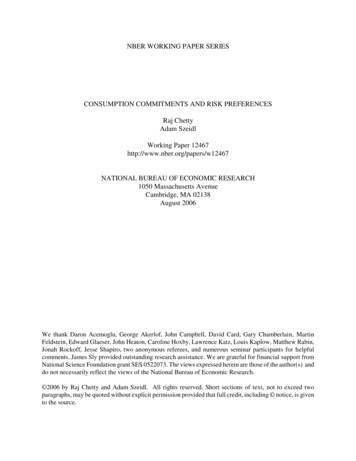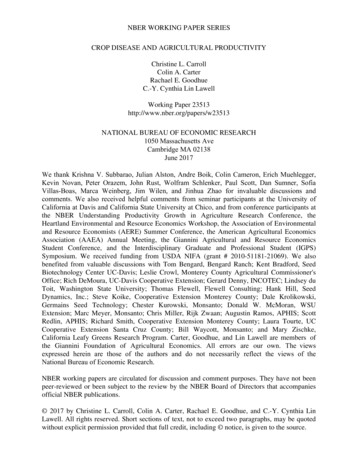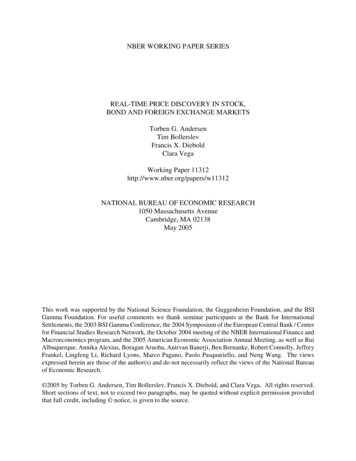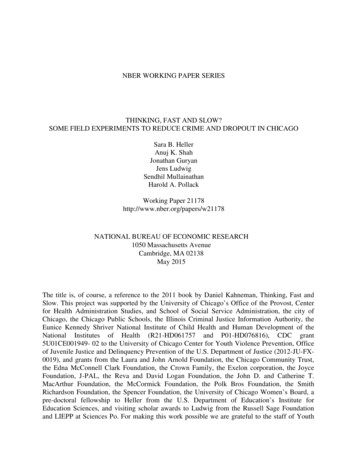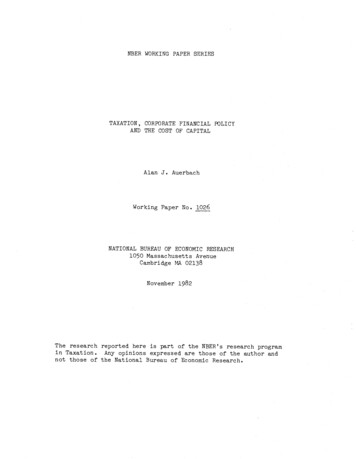
Transcription
NBER WORKING PAPER SERIESTAXATION, CORPORATE FINANCIAL ILICYAND THE COST OF CAPITALAlan J. AuerbachWorking Paper No. 1026NATIONAL BUREAU OF ECONOMIC RESEARCH1050 Massachusetts AvenueCambridge MA 02138November 1982The research reported here is part of the NBER's research programin Taxation. Any opinions expressed are those of the author andnot those of the National Bureau of Economic Research.
NBER Working Paper #1026November 1982Taxation, Corporate Financial Policy and the Cost of CapitalAbstractThe cost of capital plays an important role in the allocation of resourcesamong competing uses in a decentralized market system. The purpose of thispaper is to organize and present what is known and what is hypothesized aboutthe effects of taxation on the incentive to invest, via the cost of capital,taking full account of important issues that arise independently frpm the ques— -tionof taxation. Included in the analysis is a discussion of empirical findingsabout the interaction of inflation and taxation in influencing the incentive toinvest, and a treatment of taxation and uncertainty.Alan J. AuerbachDepartment of EconomicsHarvard UniversityCambridge, MA 02138(617) 495—3934
I.IntroductionThe cost of capital plays an important role in the allocation of resourcesamongcoxreting uses in the context of a decentralized market system. Mostsimply, it is the price paid for the use of capital resources over a definedperiod of tine. However, even in the presence of a functioning capital marketwith a well—defined rate of interest, determination of the cost of capital iscomplicated by a number of factors.Because investnnt projects are normally long—lived and irreversible, aninstantaneous opportunity cost does not suffice f or evaluating such under-takings. Likewise, risk is a majorfactorin the investment decision, inducinga dependence of the cost of capital on the risk characteristics of the asso-ciated investment. The nature of this relation depends, in part, on the extentto which markets exist for the trading of risks. The common institutionalstructure in which investment decisions are made by individuals distinct fromthose to whom investment earnings accrue also complicates matters, as does theuse of several different types of securities to obtain funds for investment.Each of these questions has provoked much thought and research. Thoughthis paper's main subject is the effect of taxation on the cost of capital, ouranalysis cannot logically be separated from these other issues. Indeed, it isthe richness of the problem of determining the cost of capital in the absence ofany taxation that contributes to the complexity of the present problem. Forexample, the existence of corporations as intermediaries in the investment decision is important not only because of the question of management incentives visa vis stockholders, but also because tax systems commonly tax such corporationsas independent entities. Much of the complexity in the analysis of the impactof taxes on the cost of capital my be traced to this fact.
—2—The purpose of this paper, then, is to organize and present what is knownand what is hypothesized about the effects of taxation on the incentive toinvest, via the cost of capital, taking full account of the issues that ariseindependently from the question of taxation. This approach makes for less certain conclusions, but perhaps appropriately so. There are many problems in thisarea awaiting satisfactory resolution.Ouranalysisbegins in Section II with a presentation of the basic model ofmultiperiod consumer optimization that gives rise to the notion of a cost ofcapital. Even in the simplest two—period framework, issues arise that mayleadto ambiguity in the definition of capital cost, and are instructive about theresults of more complex models. Section III introduces taxation in its simplestform, an incox tax. The discussion of an income tax presupposes a definitionof incon. Central to anysuch definitionfor capital income is the notion ofdepreciation, which we develop in this section. With this concept, it is thenpossible to define a shadow price or user cost of capital (Jorgenson, 1963)which accounts not only for the cost of capital as defined above, but also forthe costs of asset depreciation and taxation. Having defined the user cost inSectionIV, we then are prepared for a preliminary examination of the effects ofthe taxation on firm behavior.In Section V, we present a more realistic treatment of taxation, consideringthe interaction of corporate and individual taxes, and the special role ofinflation in distorting the xrasurenient of income. This area is a particularlycontroversial one, and we review some of the empirical work to date.In Section VI, we introduce uncertainty, beginning with the Modigliani—Miller theorem (1958). Therefollows a development of the Arrow—Debreu concept
—3—ofstate contingent commodities and prices and the simpler Capital Asset PricingModel (Sharpe, l964; Lintner, 1965) as vehicles for deriving discount ratesfor risky projects in the absence of taxation. We also discuss related issuesthat will become important in analyzing the effects of taxation, notably theeffects of incomplete markets and the problem of managerial incentives.In Section VII, we integrate the results of Section V and VI to consider theimpact of taxes on the cost of capital in the presence of uncertainty, includinga discussion of the effects of bankruptcy and tax law asymmetries with respectto gains and losses. This is the nest general of approaches, and it providessome (though perhaps not yet enough) help in explaining some of the confoundingaspects of corporate financial policy, particularly the observed patterns ofdividends and borrowing. Our analysis also includes a normative discussion ofthe welfare effects of tax—induced changes in the cost of capital in the presence of uncertainty.
—4—II.The Cost of CapitalIn a one—good, two—period certainty ndel without taxes, competitive price—taking firms maximize the welfare of their owners by accepting all investmentprojects (which defer output by a period) that earn a rate of return of at leastthe one—period interest rate. Since the interest rate is the rate at whichindividuals can convert purchases back and forth between the periods, any pro-ject that earns nre than the interest rate, r, expands the owner's budget set.With a continuum of available projects, a firm's marginal rate of returnwill equal the cost of capital. This is depicted in Figure 2.1. The firm maximizes the wealth of its representative shareholder by ving up its two—periodproduction possibilities frontier from point 01 (no investment) until themarginal rate of transformation of period 2 output for period 1 output isexactly (1 r),at point B. Stopping at point A would yield a lower wealth,WA, versus wB. The corresponding consumption choices shown, Ac and Bc, indicatea trading back of some of the period 2 output to consume mare in period 1. Thisis accomplished by borrowing at the market interest rate, r, and using part ofthe second period income to repay the loan.This result, that production and consumption decisions should be made independently, is commonly called the Fisher (1930) Separation Theorem, although itis simply a variant of the general role of the market price vector as the signalto both firm and household that produces a Pareto—Optimum in competitiveequilibrium (Arrow, 1951; Debreu, 1952). In fact, we may think of the relativeprice of period 2 consumption as P2 1rand neglect the fact that the goodsare consumed at different times.Here, the cost of capital equals the marginal rate of return. If projectswere discrete, the last acceptable project might yield a return greater than r.
—5-.Figure 2.1Welfare Maximization andthe Cost of Capitalperiqd 2slopes — (1 r)02oiWAWBperiod 1
—6—Ina model extended to several periods, multi—period projects would have to beevaluated using the interest rates from all relevant periods. The correct procedure(Hirshleifer, 1970) is to calculate the present value of each project:YPV (2.1)l rY112rr(1 r)jj lwhereis the project flow in period j, and rj the interest rate in period j,and accept those projects for which the present value is positive. This isclearly the appropriate way for a competitive firm to behave.Such results break down in the face of various alternatives in assumptions.For example, it is frequently assumed that consumers cannot borrow, or canborrow only at a higher rate than that at which they can lend. If this borrowing constraint applies to firm and owner taken together, the outcome is asdepicted in Figure 2.2.In panel A, the two possible outcomes shown are those with net borrowingand those with net lending. If the consumer is a net borrower, the firm shouldproduce at point AF in response to the borrowing interest rate rB. If the con—sunr is a net lender, the firm should produce at BF in response to the interestrate rL. From the equilibrium requirement that the consumption in the respective cases lie as shown in the vicinity of points A and Bc (indicating net borrowing and lending, respectively), the divergence of the rates rB and r' appearto increase the likelihood of an intermediate outcome, as shown in panel (b) ofFigure 2.2. Here, the consumer neither lends nor borrows. His discount rater* lies between rB and rF, and this is the rate the firm should use in its decisions. Aside from the added complexity, the problem now has the feature thatthe cost of capital need correspond to no observed market interest rate.Further, the firm cannot base its decisions on any observed rate, or any fixed
—7—Figure 2.2Welfare Maximization with a Borrowing Constraint(a)period 2Bcslope — (1 rL),slope (1 rB)Acperiod 1period 2(b)period 1
—6—combination of such rates. The discount rate at point D may lie anywhere between rF and rB. The weights to use depends on the preferences of the firm'sowner.A corollary of this breakdown ofthan oneowner, and through differencesseparation is that if the firm has morein preferences or endowments thesefind themselves in different situations with respect to borrowing andlending, they will disagree about what the firm should do. If, for example, theownersfirm initially planned to produce at point D, borrowers would wish to investless, and lenders would want more investnnt. Thus, each firm's cost of capitalwould depend on the composition of its owners, and some decision nchanisin, suchas voting, would be required to determine its policy.An additional distinction that may be introduced is between firm borrowingand individual borrowing. If the higher borrowingvidualrate only applies to indi-borrowing, for example, then it can be avoided simply by arranging forall borrowing to be done by the firm, rather than the individual. Such different treatment of an individual and a firm he owns makes little sense in avery simple nxdel. However, legal distinctions induced by provisions such aslimited liability could give rise to different borrowing opportunities. Also,as discussed below, the tax system may cause differences in effective borrowingrates.This possibility of an advantage to borrowing by firma (or individuals)makes firm financial policy a decision with real effects. If the firm canborrow at a lower rate than its owner, it can increase his welfare by increasingits borrowing, thereby allowing a reduction in his own personal borrowing. Thismakes the firm more valuable to the individual, as depicted in Figure 2.3.theIfindividual does not borrow, he will value the firm at w0 in terms of currentconsumption. However, if the firm borrows, allowing the individual access to
—9—Figure 2.3FirmFinancial Policy with Differing Borrowing Ratesperiod 2ASlope — (l rL)slope—w0period 1
—10—the lower interest rate rL, he will value the firm at w1. From another perspective, the firm's cost of capital differs according to the source of its funds.If it borrows,funds fromits cost of capital is rL. If it does not borrow, but obtainsits owners who do, it unist earn the higher rate rB. Therefore, ifis a restriction on the extent to which a firm can borrow, its cost ofcapital depends on whether it has reached this limit and now faces the higher,therepersonalborrowing cost of the margin. The observation of firr engaging inborrowing does not necessarily inly that they face a cost of capital equalto rL.Thus, the existence of more than one interest rate destroys the separationof firm policy and individual preferences and the unanimity of owners with respect to the investment decision, and introduces scope for a firm to influenceits value and cost of capital through financial policy. These results are par—ticularly relevantwhen taxes are considered.
—11—III. Capital Income TaxationMost of the taxes that influence the cost of capital are called incometaxes. But what is an income tax? The comn definition of income is the Haig(1921) - Simons (1938) measure of cash flow plus accretions to wealth. This mayalsobe put as the amount which can be consumed without a decline in the valueof wealth.In a two—period one—good model with output in each period taken as numer—(and hence no price level changes between periods), the period 1 incomefrom a one dollar investment in period 0 equals the full return less the initialairedollarinvested. For a marginal investment with zero present value, this netreturn would be r, the interest rate. In a multi—period model, period 1 incomewould equal the investment's cash flow, less the original dollar, plus theremaining value of the investment. In each succeeding period, income wouldequal cash flow plus the change in the asset's value. In equilibrium, thisvalue in each period must equal the present value of the asset's future returns.This, in turn, depends on the interest rate.For exairle, consider a project that costs one dollar and has annualreturns X over T years. If the interest rate is constant at r, then the valueat the beginning of period t T is (from 2.1)withxxV t 1(3.1)t 1 rVT(3.2)whereT(l r)TtO t T—0. From successive applications of (3.1), we may also write this as:Xt VtrVtlV V,,—0 t TEquation (3.2) may be interpreted as the equilibrium con—dition that requires a total rate of return on an asset equal to the interest
—12—rate. For a fixed vector of returns, x, and a fixed interest rate, r, equation(3.1) or (3.2) allows us to calculate the initial value V and each successivevalue. Alternatively, to determine the returns the firm mustearnto achieve anet present value of zero, we set V0 1 (the asset's initial cost) and solvefor x. Since x has T elements, we mustuniquemake a furtherassumption to obtain asolution.For example, we maytakex to be constant. In this case, the zero—present—value solution for x is:r(3.3)r) T1 — (1 From (3.1) and (3.3), we obtain the solutions for Vt and A Vt:(3.)V 1 - (1 r) (T t)(3.5) AV r'(1\(T 1t)r) T1 — Tt T—which are functions of the interest rate except in the limiting case of T where the asset is a corisol with V1 and A V 0 regardless of t.The opposite of the capital gain, A V, is coirirnn1yreferredto as the"economic depreciation" in period t of the asset in question (Hotelling, 1925).Though this derivation of A V is general, the reference to economic depreciationis normally confined to assets that wear out and must be replaced. Because ofthis association, it is important to distinguish between economic depreciationand notions of depreciation based on productivity, age, and other factors.For example, a constant output asset that produces for T years is as productive,until its demise, as its new counterpart, while its value declines steadilyafter its purchase (see (3.5)).Because economic depreciation is part of an asset's income, its measurementis important for purposes of income taxation. However, because an asset's
—13—change in value depends on future flows, it normally depends on future interestrates. One important special case which is an exception to this rule is tITLeasset with services that decline at a constant geometric rate. Such an assethas a pattern of return sumitarized by the decay rate :x x1(1)t—1(3.6)Solving (3.1) for the value of x1 needed for V0 to equal 1, we obtain(3.1)x1 Substitutionr of this value of x1 into (3.1) and (3.2) yields:Vt (1 —(3.8)—Lo)tV —Thus, the asset's value is proportional to its current productivity, as is itseconomic depreciation. Neither depends on prospective interest rates.Let us now consider the effects of income taxation on the incentive toinvest and the equilibrium valuation of assets. A tax levied at rate t on allincome, both cash flow and capital gains, would yield an after—tax cash flow ofx —t(x Vt).This could be accomplished by a tax on cash flow net of adepreciation deduction equal to —tHowever, the value of depreciationdepends on the tax rate, even if the gross cash flows x are fixed. Equation(3.2) is replaced by:(3.2')(x L V)(1— r) 0 rVt it Twhich, combined with the terminal condition that VT 0 yields:xx(3.1')V t rT . ¼ r\T—10 — t TThus, an income tax has the effect of presenting the firm with a discount rateto use in evaluating the before—tax flows x. Hence, -of capital.isthe firm's cost
Although nothing in general can be said about the response of r to changeinr,one can observe that shouldVT ibe independent of t, theobtained from (3.1) and (3.1') are the same for a given vector(Samuelson, 19614). This might occur, for exanle, ifmentsvaluescarriedopen to the firm's ownersthe alternative invest-a fixed rate of return, T(perhapsdetermined by world markets), also taxed at rate I. The opportunity cost net oftax would then be r j would not depend on i(1—t), so that (-)With d(-)/dt * 0, the pattern over time of V and hence A V for thenarginal asset (for which V0 1) depends on r. For the asset with fixedreturns over T years, for example, A V(1ic:i.be(compare (3.5)):—(T 1—t) —wouldt Tr)—TOnly for the georctrica1ly depreciating asset will t not influence the patternof capital gains, since the latter depend only on the asset's age and depreciation rate, and not the cost of capital.A major alternative to income as a tax base is personal cash—flow or con-sumption.2 In contrast to an income tax, a cash—flow tax would tax all assetreturns,but permit(3.1'')Vt a deduction for asset purchases. Thist i .1 r )XTTreplaces (3.1)with0 t T(l r) tbut also rxE.kes the initial cost of the asset, net of tax, only (l—t) ratherthan 1.Thus, the net present value of each newholding xandr fixed, is simply(1t)(V0—asseti). Theper dollar invested,value of inframarginalgains is reduced, but the cost of capital and the marginal incentive to investare not. Net present value is still maximized by accepting all projects thathave non—negative present value at the discount rate r. This tax system amounts
—15—to the assumption ofject, andapartnership role by government in each investment pro-so is equivalent to a tax on an enterprise's economic rents (Brown,l9!8) .3Both consumption tax and income tax approaches lead to outcomes in whichpure rents are taxed and firms evaluate all projects with a single discountrate.This result may also be generalized by combining the two approaches.that allows immediatea fraction of economic depi-ecia—Consider a tax system with gross flows taxed at rate texpensingof a fractionof investment withtion permitted as a deduction each year. This leads to the transition equation:(3.2''') xt(l t) v(i—p)rVti0 t Tand hence the valuation forni.la(3.1''') t X1(1T)r(i l—4T0 t T—XT(1 r)T t1—4tIf we take account of taxes, the asset's initial out—of—pocket cost is(3.10)P0 —Now, suppose c (V0 1,—1)so that firmx mayexpenseinvestment and receive deductions for a fractiontion. In this case, we mayexpressa fraction (l—) of theirof their economic deprecia-(using (3.1''') and (3.10)) the net presentvalue of a one dollar gross investment as:x(3.11)V —0P0 1(l—t)(i ITx T(i — 1Hence, the firm should accept all projects for which the net present value ofbefore—tax flows is positive, discounted at the rate, whichdefines thisrate as its cost of capital. As with both income and consumption taxes, initialrents are taxed at rate r.Thus, all tax systems for which p 1,including
the extreme limits where a 1 or 4 1, combine a rent tax at rate t withcostof capital equalsystemstorIf r—is invariant to changes inor t,aallare "neutral" in the strong sense of not influencing the incentive toinvest. Generally, they are neutral in the weaker sense that they cause firmstouse the same discount rate for evaluating gross—of-tax flows from eachinvestment project, regardless of the project's characteristics.
—17—IV. Taxationand the User Cost of CapitalProbably the most familiar model used in the analysis of taxation's effecton investment is the neoclassical model introduced by Jorgenson (1963), the maincomponent of which is the "user cost of capital," which is a summery statisticfor the overall incentive to use capital in production.5 The user cost differsfrom the notion of the cost of capital defined above in that it includes a component for asset depreciation, and allows for a broad range of tax schemes.The basic model that gives rise to the user cost is of a firm producingoutput using a single capital input. Without loss of generality, we may thinkof capital as the only input in a production function:Y F(K)(.i)F' 0, F'' 0where units of capital services are in terlis of those offered by new capitalcosts.The presence of two distinct goods, capital and output, in each periodrequires the introduction of at least one relative price. However, becausethere is another commodity, money, implicitly present, we introduce two moneyprices, that of capital goods,and output t' for each period t. Thisallows for general price inflation, which, as discussed below in Section .,has important real effects on the cost of capital via focus of the tax system onnominal magnitudes.At leastformulation.two key assumptions lie behind the simplicity of the user costFirst is the restriction to exponentially depreciating capitalgoods. As shown in Section III, these goods have thedesirable property of aneconomic depreciation rate that is invariant with respect to the interest rate.This allows the representation of depreciation as a technological pararxter inthe user cost formula. Similarly, the assumption of a constant (from the firm's
—18—viewpoint) nErginal cost of new capital goods nEkes the priceexogenous.Neither of these simplifications is necessary for the derivation of the usercost as the shadow price of capital, but they are required for other applications.Though the user cost can be derived from a discrete time model such asthoseexamined above, it has come more commonly from a continuous time formula-tion,which we follow here.Since capital services decay exponentially at rate 6, we n.y think of aunit of getcapital simply as —6tunits of new capital.6 Thus the capitalstock at time t isKt (14.2)wherer e(t 5)iJSdSis investment at date s t.Differentiating (14.2) with respect to tyields the transition equation: -eachThe firm's optimization problem involves the choice of investment attime to nEximize the wealth of its owners. Without taxes, this is:(14.14)maximize w Je' [PtFt—qIlSubject to (14.2) or (14.3), this amounts, as one would expect, to the choice ofinvestment at each date so that the net present value of future capital servicesis zero at the margin. Indeed, if we substitute the Kt in (14.14) using (14.2),and differentiate with respect to 't we obtain just this result:(14.5) tj e r t)p F'55et)d5
—19—where F' is the irginalproductof capital at date s. However, a more usefulway of expressing this result comes from substituting instead for Iusing (.3), and solving with respect to K. The Euler condition, which musthold at the optimumF' t(14.6)The termyields:qC t(r —(.)qt 6)is the famuhia.i' expression for the user cost of capital, expressingthe shadow price of capital at time t. The fact that investment decisions madeat date t should depend onlyonconditions precisely at that date, and not onthe future, results from the lack of constraints on capital stock adjustnnt orinvestment reversibility (Arrow, 19614). We discuss this further below. Tointerpret (14.6),noteF — [6(14.7)that it can be rewritten:— Er —()1()This expression is analogous to (3.2). It states that, in output units, thetotal earnings at date t from an investnnt, the marginal product plus the realchange in asset value, must yield a rate of return equal to the real interestrate r —The rate of economic depreciation iS —(.) takesaccount ofchanging relative prices. This choice of units affects the measure of income,but not the user cost itself.One of the frequent early criticisms of the user cost approach was thatwhile it was based on a ndel with zero adjustment costs, it normally appearedin aninvestment equation specifying the partial adjustnnt of capital to thedesired stock dictated by (14.6). while son authors (including Eisner andStratz, 1963; Lucas, 1967; Gould, 1968; and Treadway, 1969) derived conditionsunder which such partial adjustment was consistent with optimizing behavior,
—20—there is no general result in this vein. However, another way of' looking atthis problem is that the user cost itself is inisspecified. In particular, ifthe true cost to the firm of new investment goods is included in the optimiza-tion, the result willbe a correct nasure of the user cost, to which firmssettheir contemporaneous n.rginal product of capital.For example, suppose it is costly for the firm to add new capital goods toits stock quickly, so that it faces a convex adjustment cost in addition to theunderlying, constant capital goods price. Then the total cost of new investmentgoods is:(I) .(i.8)where q(.)is ( the convex adjustment cost function (', O)'andq(I) is thetotal average cost of new capital goods to the firm.Replacingwithin expression (14.l.i), andagainn.ximizing with res-pect to K, we obtain the analog of (.6):(1.6')F' C Cr - qwhere(L.9)dlis the i.rginal cost to the firm of new capital goods.Unfortunately, whilemaybe observable,is not, at least on thesupply or cost side. On the demand side, we know thatequals the discountedflow of marginal products (as in (1.5)) but these, too, are unobservable atpresent and will change withachange in tax policy. However, following Tobin's(1969) initial insight, authors nxre recently (Abel, 1979; Hayashi, 1981) havepointed out that although the marginal cost q is unobservable, it is related to
—21—the firm's market value. Thus, one can, for example, parameterize the adjustment cost function c(.),solve equation (.9)forI in terms of q, and regress.This is an important issue f or predicting the short run impact of tax poli-cies on investment. In the long run, this problem is less important. As ourfocus here is on the long run effects of taxation on capital allocation ratherthan on the short run impact on investment, we return to the simplified model inwhich the supply probe of capital is constant.A number of major tax code provisions may be introduced into the user costformula. We assume there to be a single income tax, assessed at rate t on cashflow PtF(Kt) less depreciation allowances on existing capita. In addition, weassume there is an investment tax credit at rate K on new capital goods pur-chases.8At this point, we ignore the additional complications of personaltaxation and the special treatment of debt. One may think of this user cost asthe one that holds for a self—financed entrepreneur.Letting Dt be the depreciation allowance given a unit of capital originallypurchased for a dollar, we obtain the following optimization problem:(hlO)w fet Jet{(1.t) PtF(Kt) —q(i k)i{(i t) ptF(I) —q(1 k tZ)I} jtqsisDtSd ds} dtt JtqI5D 5dswhere(1.ii)Z J e'rtDt dt0isthe present value of depreciation allowance accruing to a dollar of new cap-ital, all tax parameters are constant, and investors never sell or buy used cap-ital goods.9 Solving (1.iO) with respect to Kt, as before, yields:
—22—(.l2)F' C (r- )(i-k -Comparing (1.l2) to (1.6), we see that they differ by the ratio(1 —k—tZ)/(i—'r),which may be interpreted as the effective reduction in subse-quent cash flows. As already shown, when these two factors are set equal throughexpensing (k 0, Z 1),the marginal incentive to invest is unaffected bytaxation. Likewise, this property holds whenever Z 1.A special result also holds when depreciation allowances correspond to eco-nomic depreciation. This is mosteasilyshown when prices are stable, in whichcase:(14.13)soDt that Z r5etand (dropping subscripts) c (-- 6).This corresponds to the earlier result that economic depreciation results in theuse of a discount rate equal to .TL in evaluating gross of tax flows. Likewise,expensing and economic depreciation can be combined to give a result corresponding that in (3.l1).10pical tax systems treat assets differently, of course. Aside from theproblems caused by inflation, there is a gap between the patterns of economicdepreciation and those of depreciation allowances.11 This means that there isno general cost of capital, but a different one for each potential project.This project—specific discount rate maybederived from the user cost forxriila(14.12)We begin by noting that a marginal investment is one for which the irgina1product of capital equals the user cost. Hence, the gross return from such aproject t years after purchase would be C e6t units of output or ptCte6t
—23—dollars unit of capital. Hence, the discount rate p that results in theproject's gross flows having a zero net present value is defined implicitly bythe equation4.l4)q0 —óte —ptPCe dtSubstituting in (li.iI)for(r o)(J.C using (1.l2) yields (dropping subscripts):- k-tZ)(o(l—T)—-i)Since p is determined by nominal cash flows, it is the nominal cost of capital.The rea
NBER Working Paper #1026 November 1982 Taxation, Corporate Financial Policy and the Cost of Capital Abstract The cost of capital plays an important role in the allocation ofresources among competing uses in a decentralized market system. The purpose of this paper is to organize and present what is known and what is hypothesized about

